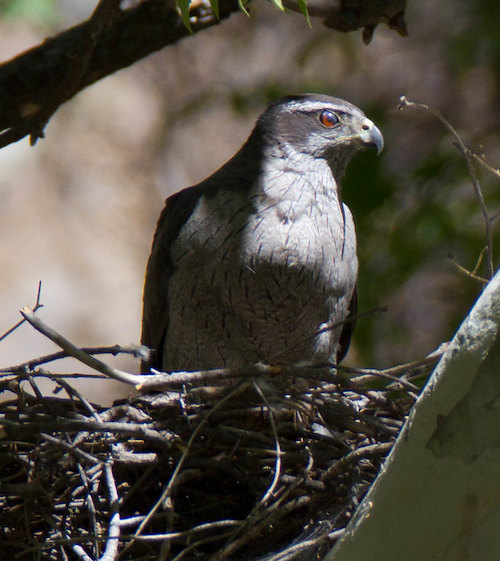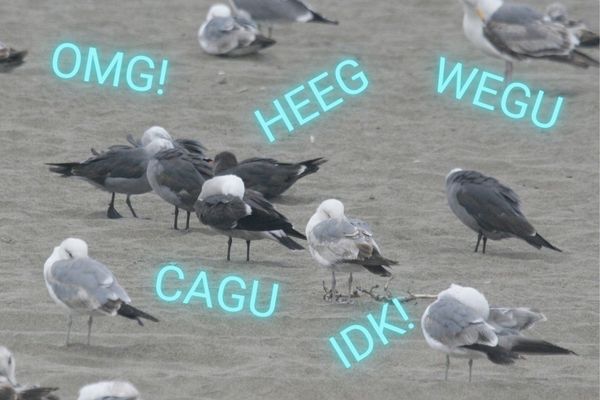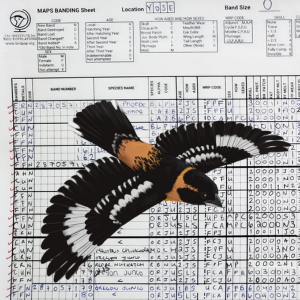The other day I went down to the beach to study molt in WEGUs and CAGUs. A group of MODOs flushed from the dunes and, offshore, a PEFA and CORA were battling it out over a feeding flock of BRPEs, BRACs, and COMUs. Huh? Some of us are actually beginning to speak like this, using four-letter codes instead of the full "common" (English) names for birds. It seems to be a trend, not just in birds but, BTW, in social media which was dealt a recent blow by the demise of the little blue bird logo, RIP (LOL, IMHO). But there is also a satisfying effectiveness to these codes, at a time where we need to think more efficiently in our efforts to slow down global climate change. In the bird world, for example, these codes allow banders to quickly enter data on banding sheets, reducing handling time.

During my time on the Farallon Islands I tried very hard to confirm a Cordilleran Flycatcher, which undoubtedly occur sometimes at this famous vagrant trap, but I could not. Then I realized we really had never confirmed the common coastal Pacific-slope Flycatcher there either! So we put them all down as "Western Flycatchers" and as WEFL on our banding data sheets. There was good reason for this, as the two taxa undergo an even cline in appearance and vocalizations around its horseshoe-shaped breeding range through Alberta and British Columbia (the split was based on comparing coastal populations with those on the other side of the Sierra Nevada). Many of us have been squabbling about this for years and the AOS has finally agreed, re-lumping the two as Western Flycatcher. So welcome back WEFL! Photo: Becky Matsubara.
Somehow, the founder of Institute for Bird Populations (note, IBP), Dave DeSante, and I became the keepers of the alpha codes for North and Middle American birds, and we have published updated versions annually on the bird species code page at the IBP website since 2003 (you can search on the lists there if you had trouble understanding the first two sentences of this piece). In 1978, a functional set of codes was developed by the "USGS" Bird Banding Lab (BBL; here) by a couple of my banding mentors, Kathy Klimkiewicz and Chan Robbins. The codes were based on the initial letters of the words in the common names, for example, Northern Cardinal (NOCA), Long-eared Owl (LEOW), American Golden-Plover (AMGP - note the different format, not "AGPL," when a hyphen is involved in the group name), Bushtit (BUSH), American Three-toed Woodpecker (ATTW), and I think you get the picture. Despite some subsequent efforts, these 1978 codes were not updated very often, suffered from some lack of rules consistency, and did not cover most birds that occur strictly in Mexico, Central America, and the West Indies. In 2002, Dave initiated the MoSI Program and we needed alpha codes for resident species captured at banding stations in these Neotropical areas. So he set me to the task and we published our methodology and strict rules for deriving these codes in a 2003 paper for North American Bird Bander.
We based our initial codes on the names and taxonomy of the (then) American Ornithologists’ Union (AOU), now the American Ornithological Society (AOS). In 1998 the AOU published their Checklist to North and Middle American Birds, which included all species in the MAPS and MoSI regions. Simple enough to just make codes, right? Wrong. The biggest issue with these codes is when those for two species conflict with each other. For example, Cedar Waxwing and Cerulean Warbler would both get CEWA according to the rules. For such conflicts neither species should be coded CEWA, as this would lead to confusion regarding which species was intended in places where both species occur. So, in this case, the waxwing gets CEDW and the warbler CERW (see our 2003 paper for more details than you care to know about conflict resolution).

Our telemetry studies on Northern Goshawk are now on American Goshawk, due to the split of American from Eurasian goshawks this year. So NOGO is now a no go, and the goshawk code becomes AGOS due to a new conflict with AMGO, the former beloved code for American Goldfinch. Photo: Aaron Bugdor.
As you can imagine, adding some 1000 Neotropical and vagrant species to the 1978 list resulted in many more conflicts, some of which would upend long familiar codes. For example, our familiar OCWA for Orange-crowned Warbler conflicts with the code for Olive-capped Warbler of Cuba and the West Indies. In order to avoid disrupting such familiar codes, we set up a category system whereby those birds breeding in the U.S. and/or Canada get priority over those found but not breeding here, and then over those that do not occur here at all (so OCWA stays OCWA and Olive-capped Warbler gets OCAW). Not perfect, but it did serve to preserve many familiar codes long used by North American banders. And, by the way, since many MoSI operators use scientific rather than English names, we also derived a set of six-letter codes for their use, using similar sets of rules based on the genus and species names, which are now widely used on MoSI banding sheets instead of the four-letter codes. For example: Passerina ciris, PASCIR (for Painted Bunting, PABU).
OK, the next big issue was how to deal with name changes by the AOU/AOS, when they come out with their annual updates ("supplements") to the AOU Checklist. Name changes can occur when species are split, species are lumped, or in some cases the name is not appropriate for other reasons, such as when White-necked Raven (which lacks any visible white feathering) was changed to Chihuahuan Raven (CHRA) or McCown’s Longspur was changed to Thick-billed Longspur (TBLO, a name-change subject for another day). We deemed it necessary to strictly stick to the conflict-resolution rules for new names, despite the fact that some familiar codes would change. The worst example of this was when we had to change Yellow Warbler from YEWA to YWAR due to the addition of Yellow Wagtail (YWAG, which breeds in Alaska), and then back to YEWA when the name of the latter was changed to Eastern Yellow Wagtail (now EYWA) by the AOU in 2011.
Unfortunately our strict system, which we needed to maintain for all birds, results in a few codes that differ between our list and those of the BBL, those that banders need to put on their data submission schedules. Most of these are due to the BBL taking a year or two to adjust to recent name changes by the AOS, but some have to do with their not wanting to change long-used codes. An example of both of these factors is for Common Ground Dove, a name for which the AOS removed the hyphen between "Ground" and "Dove" in 2019. Our strict rules dictate that this removal results in COGD becoming CGDO, but the BBL still has it as COGD. Here at IBP we have dealt with it though our MAPSPROG program, which is updated yearly to take care of these differences. These differences (as of last year anyway) are also listed in the Second Edition of my Identification Guide to North American Birds, in the species headers as, e.g., "CGDO (BBL:COGD)." Other examples of differing codes are for Barn Owl (BANO vs. BNOW for the BBL), Barred Owl (BADO vs. BDOW), Eurasian Collared Dove (EUCD vs. ECDO) and Broad-tailed Hummingbird (BTHU vs. BTLH). This last change occurred when BTHU was "released" by the name change of Blue-throated Hummingbird to Blue-throated Mountain-gem (now BTMG) in 2019.

At the same time we welcome back WEFL, we say goodbye to our dear old AMGO (see AGOS, above). I have faith that we'll all get used to AGOL in time. One thing to be thankful for, in any case, is that our familiar little bird in the hand was not called the American Holdfinch. Photo: Mick Thompson.
Each year we dutifully update our alpha codes, most recently on our webpage based on changes published by the AOS in their 64th Supplement (July 2023). Not as many changes as usual were needed this year, and the great majority involved species that do not occur in the U.S. and/or Canada. One important change, however, concerned the lumping of Pacific-slope and Cordilleran Flycatchers to its good old former self, Western Flycatcher, resulting in the reinstatement of WEFL and the demise of PSFL. In this case, COFL was removed for Cordilleran Flycatcher but was released and now used for Cocos Flycatcher (of the namesake island off Costa Rica), which had been COCF (see here for details on 2023 changes). Another change involves the split of Northern Goshawk to Eurasian (EUGO) and American (AGOS) goshawks. So NOGO is now a no go, but why AGOS? Well, a tragic reality of our strict system is that some familiar codes sometimes have to change (e.g., see YEWA above). In this case, we now have a conflict between the codes for American Goshawk and American Goldfinch, necessitating a change from the beloved AMGO to AGOL. (See this paper for conflict resolution rules and here for specifics on this split and other changes that occurred in July 2023.) Thankfully, in these days of database technology, making such universal changes in our MAPS and MoSI databases are fairly straightforward. By the way, finally, I sometimes amuse myself by turning non-bird monikers into alpha codes to see what they look like, such as IBPO, AOUN, AOSO, and BBLA in this essay.






